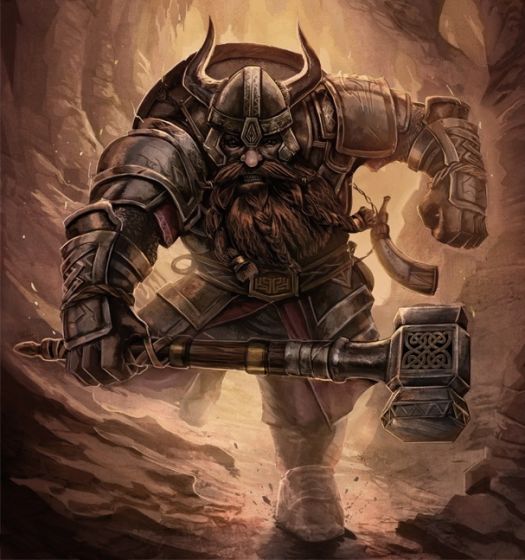Overbearing
Overbearing is a form of melee combat where the combatant aims to physically push or compel an opponent to move back from their defensive position, or combat hex, during battle. The combatant, often with a strong and sturdy posture, lunges or advances toward their opponent with unwavering determination. Their muscles tense as they use their body's mass and strength to execute the maneuver.
Contents
The attack can be visualized as a powerful shove or push, where the combatant's weapons and upper body make contact with the defender's body or shield. Designed to disrupt the defender's balance and footing, the attack works best as multiple combatants use this to break an enemy's thinly-held line in a large battle.
| Ratio of attacker to defender | Roll to hit modifier |
|---|---|
| up to 24% | cannot overbear |
| 25-32% | -12 |
| 33-41% | -9 |
| 42-58% | -4 |
| 59-71% | -2 |
| 72-87% | -1 |
| 88-116% | none |
| 117-141% | +1 |
| 142-175% | +2 |
| 176-250% | +3 |
| 251-350% | +7 |
| 351% or more | +10 |
Attack Roll
Before making a roll to determine a hit, combatants declare an intent to "overbear" their opponent. The combatant must then allocate all their action points (AP) for both the attack; this cost allows the combatant, if the overbearing succeeds, to freely advance one hex forward. Combatants with multiple attacks can roll to hit for each attack, but the movement cost remains the same. Each successful hit does cause 1-3 damage, adjusted for strength.
When attacking, a d20 is rolled as always. This is not a conventional attack, however; visualise two combatants locked in close quarters, pushing against each other while still holding their weapons and shields, rendering their weapons less effective than in a typical attack. As the table indicates, the attacker's weight is compared to that of the defender and the modifier obtained.
- For example, Caitlyn has a weight of 180 lbs. and wishes to push the 215 lb. Dray out of his hex. Caitlyn is 83.8% of Dray's weight, which by the table gives him a penalty of -1 to hit Dray's armour class.
Some may wish to account for the "whole weight" of both attacker and defender to be taken into account, including gear, armour and so on. It can be taken that the combatant's equipment is a detriment rather than a benefit, but this is for the DM to decide. Obviously, discounting gear enables the calculation to be made more swiftly, simplifying the action in combat.
Battle Movement
The image below illustrates the outcome of a successful overbear maneuver. In this scenario, Caitlyn presses into Dray's hex, forcibly displacing him from 0518. If Caitlyn's overbear attempt were unsuccessful and the far left picture would show the end of Caitlyn's turn. Instead, Caitlyn's attack pushes him back into 0618. She herself then occupies Dray's former hex.
Normally, to achieve this effect, Caitlyn would have to stun Dray, causing at least a quarter of his hit points. Instead, though she only causes 1-3 damage, regardless of whether or not Dray is stunned, he's forced back. If he's not stunned, then he's free to attack with his next turn from 0618 — and even, perhaps, overbear Caitlyn in return.
indicates the movement produced by a successful overbear. Caitlyn forces herself into pushing him back out of 0518. Were she not successful, no movement would occur. If it should happen that the damage done to Dray caused the latter to be stunned, Dray would not fall back another hex as indicated under those rules. And if Caitlyn were possessed of multiple attacks, she would be able to roll again to overbear, pushing Dray out of hex 0618.
Multiple Defenders
Let us suppose that Dray is supported by a second defender in 0618, "Ewan." If that were the case, then Caitlyn's success at overbearing would have to take into account the combined weight of both Dray and Ewan. As she pressed upon Dray's front, Ewan's able to help maintain his balance and apply pressure from the rear against Caitlyn. The rule gives good reason for armies entering a fight to approach in "ranks," with a rear line of combatants supporting a front line.
However, suppose that Ewan in 0618 were engaged with yet another combatant, Falen. If he were so engaged then Ewan could not support Dray against Caitlyn. Thus, a back rank of combatants are only useful to the front rank if they're not themselves engaged, as they might be if the ranks were "broken" or "flanked." If Ewan were so engaged, and Dray were pushed back out of 0518 and into Ewan's hex, then both might be "fouled" as combatants, producing a situation of multiple defenders in one hex.
Overbearing against Multiple Persons
Should a combatant attempt to overbear against a situation of multiple defenders in one hex, two salient points would have to be taken into account. First, that the overbearer would receive a +2 bonus in attacking fouled defenders — unless those defenders were trained to fight in close quarters. Additionally, as described above, the combined weight of both or all defenders must be taken into account when calculating bonuses or penalties to hit with overbear.
However, if the overbearing proved successful, it's taken that the hex has been cleared, displacing both defenders from it. Strategies of this kind could drastically undermine the fighting capacity of a defending force, in a manner reflecting mass combat of that time period.
See also,
Crashes & Collisions
Charging
Grappling
Pummelling
Unarmed Combat (sage study)

